
Hands on Review: Northern Brewer Anti-Gravity Transfer Pump
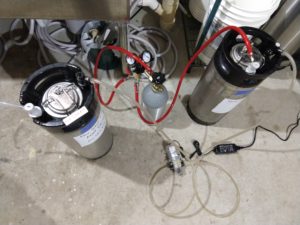
Updated: 5/3/2024
This review is by Homebrew Finds Contributor Brad Probert. Brad is an engineer, expert homebrewer and experienced reviewer. Grab a link to Brad’s website at the end of this review.
Northern Brewer Anti-Gravity Transfer Pump
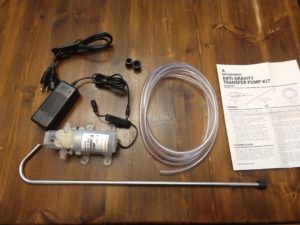
Some homebrew gear has a wide range of use, and some fills a very specific purpose. Those that fill a specific purpose typically become a critical piece in your process that you wonder how you managed before you had it. For me, that was the Anti-Gravity Transfer Pump from Northern Brewer. This pump is specifically intended for use in transferring beer or wort from vessel to vessel during your fermentation and/or kegging processes.
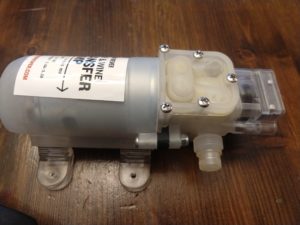 Closeup of Pump Head
Closeup of Pump Head
The Anti-Gravity pump is a diaphragm pump, which is different than your typical wort pump. Wort pumps are usually an impeller design with a pump head inside with rotating blades that push little bits of fluid along from the inlet to the outlet as they spin. A diaphragm pump has a flexible membrane inside that oscillates back and forth like a trampoline. When the membrane is pushed in one direction, it compresses the fluid and forces it to the outlet. And when the membrane is pulled in the opposite direction, it creates a vacuum in the pump chamber which draws fluid in. A set of check balls ensures flow only goes in one direction.
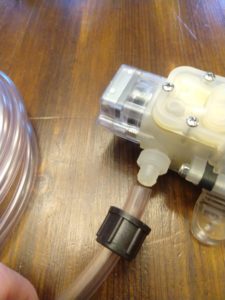 Hose Connection on Inlet and Outlet
Hose Connection on Inlet and Outlet
Check Prices and Availability, Review Continues Below:
- Self-priming Anti-Gravity Transfer Pump – via AIH
- Self-Priming Anti Gravity Transfer Pump – via AHS
- Northern Brewer – Anti Gravity Self Priming Beer Transfer Pump Kit – affiliate link, note that multiple variations of this product may be available, as such a different version may appear at this link
This article contains affiliate links. We may make a small percentage if you use our links to make a purchase. You won’t pay more and you’ll be supporting Homebrew Finds and more content like this. Thank you for your support!
Diaphragm pumps are self-priming, meaning they can handle sucking in some air and pushing it through the system until they get a steady flow of liquid. Impeller pumps are not self-priming, and thus you have to do the dance of turning them on & off and working to remove air bubbles from the lines. Because of the priming function of diaphragm pumps, they are well suited in transferring liquids from vessel to vessel. Self-priming also means you don’t have to worry about ensuring one vessel is higher than the other, or that the pump is located lower than the source vessel. However, diaphragm pumps do not handle output flow restriction very well, and typically aren’t rated for high temperatures, so they aren’t well suited for handling wort during mashing or boiling processes.
The Northern Brewer Anti-Gravity pump can handle liquids up to 140F, has a suction ability of up to 5 ft and a maximum lift of up to 150 ft (with 5/16” line). These numbers of suction and lift are what gives it the “anti-gravity” moniker, as you can easily envision various arrangements of vessel to vessel transfers where your source vessel is on the floor and your destination vessel is up on a table or bench. No bending over to pick up a carboy full of beer. Or you could put your purged keg in your keezer while it’s empty and then transfer the beer into it from your fermentor sitting outside. No lifting up and over that keezer collar.
The kit comes with the pump, a length of 5/16 beer line to cut into a length for inlet, and a length for outlet, a stainless steel racking cane if you don’t have a spigot on your fermentor, and a voltage converter to plug in to a regular 110V outlet and convert to DC voltage for the pump. The pump powercord has a nice simple on/off switch for one-handed use.
Hands on Review
I recently ventured into the world of low-oxygen beer transfers and kegging after having a lot of bad luck on my hoppy IPAs getting oxidized really quickly. The improvements in my IPAs has been notable, and I’m hooked. However, I found myself seeking out improvements to very slow transfer times. Gravity feeding beer from the spigot of my fermentor sitting on a benchtop, into a purged keg on the floor, was a very slow process. It all got there in the end, but it required A LOT of patience. I also recently started cold crashing in a keg. And gravity feeding dry-hopped beers into a Corny turned out to be a disaster as hop debris would clog the ball valve and the pressure from gravity feed wasn’t sufficient to clear it.
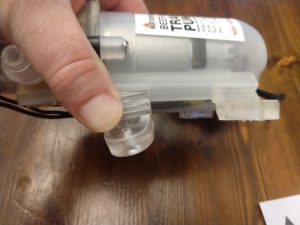 Flexible Mounting Feet
Flexible Mounting Feet
The pump is shipped with sanitizer inside, and it’s also supposed to be stored that way. This helps prevent the diaphragm inside the pump from drying out and keeps it flexible for its pumping operation. After flushing with a StarSan mix through the lines and pump, I hooked the inlet hose to the spigot on my Brewtech Brew Bucket, and the outlet hose I pointed into an empty pitcher. Activating the switch, the pump buzzed to life with a high-speed clicking/buzzing reminiscent of a tattoo gun. There are very flexible mounting feet that you can use to mount the pump down to something solid if you want. After pushing all the StarSan through until I was getting a pure beer stream, I took a sample for a gravity check and then hooked it up to a ball lock feeding my oxygen-purged keg. Having the transfer lines all filled with beer before starting to fill the keg helped minimize oxygen pick up.
This first transfer from fermentor to keg was a Helles Lager, so there were no dry hops in the fermentor, and a relatively few hops used in the boil. The pump is rated at 1 gallon per minute. It certainly seemed faster than that, as when I went to lift the keg to check the progress, I realized it was nearly finished transferring the whole thing.
 Transfer of Hoppy Beer from Cold Crash Keg to Drinking Keg
Transfer of Hoppy Beer from Cold Crash Keg to Drinking Keg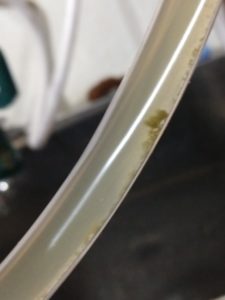 Dry Hop Debris in Transfer from Fermentor to Keg
Dry Hop Debris in Transfer from Fermentor to Keg
The big test for the pump was my second batch, which was a hazy pale ale and used 4 oz. of dry hop pellets floating freely in the 5 gallon batch (no bags, no hop spiders). This time I was prepared with a stopwatch, and transferring 5 gallons of hoppy beer to my cold crash keg took 5.5 minutes. I had considered trying to hook up a filter, but opted to go without to give the pump a good test. As I watched repeated bits of hop debris come through the line, I tensed up whenever I saw a big chunk coming. The pump buzzed a bit louder briefly, but just plowed on through.
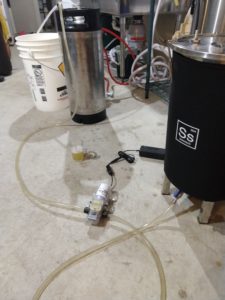 Transfer from Fermentor to Cold Crash Keg
Transfer from Fermentor to Cold Crash Keg
After spending a couple days in my cold crash keg (with floating dip tube), I was planning to just use CO2 pressure to transfer from cold crash keg into my “drinking keg”. But after about a quarter gallon pushed through, the flow had stopped. I figured I’d give the anti-gravity pump a shot at it, and sure enough, it was able to successfully transfer the beer. I found after transferring it the cold crash keg poppet had filled up with hop debris. While this was too much for 10 psi of CO2 to push through, the anti-gravity pump was able to transfer the beer. Once again saving my low oxygen transfer processes.
Conclusions
Overall, I was very impressed with this pump. With its specified temperature rating of 140F, its uses are limited to just moving beer around once in the fermentation stage. With its self-priming function, it provides versatility in moving beers up or down throughout your fermentation space. Coupled with the diaphragm design, it opens up new options for you in managing cold-side beer transfers without inducing a lot of oxygen along the way. The ability to power through hoppy fermentations without getting stuck also helps broaden your options in low-oxygen transfer methods- because nobody likes wet cardboard in their beer!
Check Prices and Availability, MORE Photos Below:
- Self-priming Anti-Gravity Transfer Pump – via AIH
- Self-Priming Anti Gravity Transfer Pump – via AHS
- Northern Brewer – Anti Gravity Self Priming Beer Transfer Pump Kit – affiliate link, note that multiple variations of this product may be available, as such a different version may appear at this link
More Photos
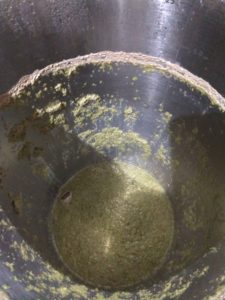 Dry Hop Slurry Left in Fermentor After Transfer
Dry Hop Slurry Left in Fermentor After Transfer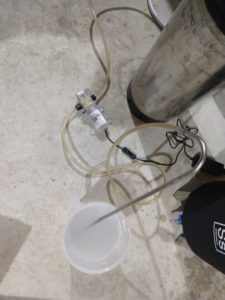 Purging Pump with StarSan for Storage
Purging Pump with StarSan for Storage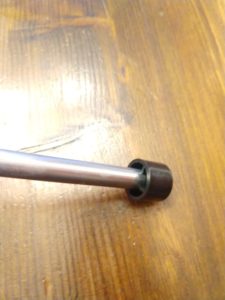 Racking Cane Cap to Minimize Sluge Pickup
Racking Cane Cap to Minimize Sluge Pickup
More Pump Reviews!
More Homebrew Finds!
- Last 50 Finds!
- Top Deals – a curated list of the best deals
- Homebrew Reviews – one of the largest libraries of homebrew reviews in existence!
- Our Top Posts – tips, how-tos, resources posts and more
- Let’s be Friends!
Recent Deals!
10 Most Recent Homebrew Resource Posts & How-To’s!
We are Homebrew Review HQ! Our 10 Most Recent Reviews
pinnedThis post may contain affiliate links. We may make a commission when you use our links. This will never cost you extra. Thank you for supporting Homebrew Finds!
greatdealsBy Brad Probert. Check out Brad’s website – beersnobby.com
Special Thanks to Northern Brewer for providing the kit used for evaluation in this review.
Make sure the components you use are compatible and rated for your intended application. Contact manufacturer with questions about suitability or a specific application. Always read and follow manufacturer directions. tag:lnksfxd review:nbagtp rs:7 tag:tpr













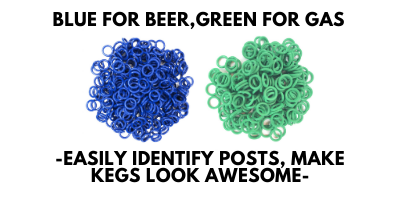




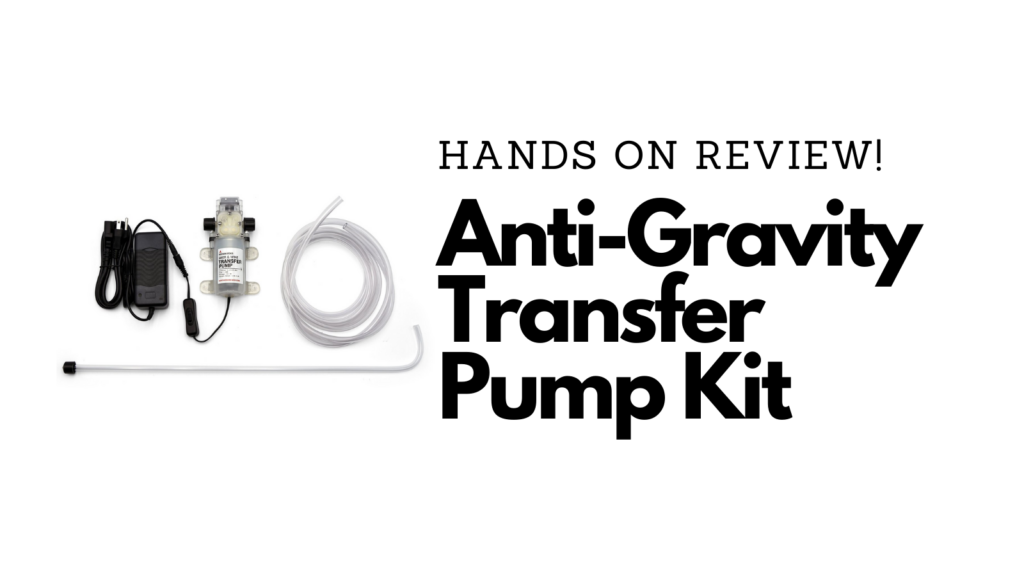
hello, someone has the assembly handle of this pump, I disassembled it to look at a leak and I have not been able to put it back together